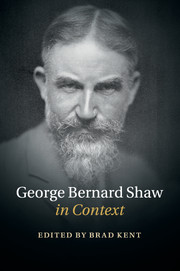Book contents
- Frontmatter
- Dedication
- Contents
- List of illustrations
- Notes on contributors
- Preface
- Acknowledgements
- A Chronology of Shaw's Works
- List of abbreviations
- PART I PEOPLE AND PLACES
- 1 Dublin
- 2 The Fabian Society
- 3 Germany and Austria
- 4 London
- 5 Oscar Wilde
- 6 W. B. Yeats
- PART II THEATRE
- PART III WRITING AND THE ARTS
- PART IV POLITICS
- PART V CULTURE AND SOCIETY
- PART VI RECEPTION AND AFTERLIFE
- Further reading
- Index
- References
1 - Dublin
from PART I - PEOPLE AND PLACES
Published online by Cambridge University Press: 05 October 2015
- Frontmatter
- Dedication
- Contents
- List of illustrations
- Notes on contributors
- Preface
- Acknowledgements
- A Chronology of Shaw's Works
- List of abbreviations
- PART I PEOPLE AND PLACES
- 1 Dublin
- 2 The Fabian Society
- 3 Germany and Austria
- 4 London
- 5 Oscar Wilde
- 6 W. B. Yeats
- PART II THEATRE
- PART III WRITING AND THE ARTS
- PART IV POLITICS
- PART V CULTURE AND SOCIETY
- PART VI RECEPTION AND AFTERLIFE
- Further reading
- Index
- References
Summary
Dublin-born Bernard Shaw lived his first nineteen years and nine months in Ireland's capital city. Emigrating to London in 1876, he would not return for over thirty years to a Dublin changed from the city he had known as a youth, although its infamous urban poverty persisted unchanged.
Having neglected the city, Shaw made eight visits from 1908 to 1922. In fact, Shaw along with his Irish wife, Charlotte, visited Ireland fourteen times between 1905 and 1923. As pioneer motorists, they toured all over the country, with West Cork, Kerry, and Abbey Theatre playwright and director Augusta Gregory's house, Coole Park in Co. Galway, as preferred destinations – not Dublin.
Dublin, however, had become the site for the splintered energies of an ever more hopeful national revival seeking to sever constitutional links with England/Great Britain. After the long-promised third Home Rule Bill (1912) was set aside following the outbreak of World War I, the city's social, political, cultural, and polemical tensions, simmering since the fall of Parnell in 1891, boiled over in armed revolution with the 1916 Insurrection, the War of Independence (1918–21) and, finally, the Civil War (1922–23), leaving Ireland divided into two inconclusive politically determined entities: the northeast corner preserving constitutional links with Britain, the remainder, its own nation state, maintaining only vestiges. Shaw, resolutely opposed to xenophobic Irish nationalism, aligned himself with broader nationalist interests by working behind the scenes for both the Irish National Theatre at the Abbey and the 1917 Irish Convention. He also made many public interventions (letters and speeches in both London and Dublin), including lending his support to Larkin, Connolly, and the Dublin workers during the 1913 Lockout, and defending the 1916 Dublin Rising leaders.
Four distinct incarnations of Bernard Shaw's Dublin arise: Dublin 1856–76: the mid-nineteenth-century city in which he grew up and knew intimately; Dublin 1876–1908: the city that developed during his thirty-two years’ absence, familiar from Joyce's Ulysses, which Shaw claimed confirmed his own bitter experience of Ireland's capital; Dublin 1908–22: the turbulent centre of the Irish National Revival, to which Shaw frequently returned; and Dublin 1922–50: the capital city of the new Irish Free State, later renamed Eire (1937), and finally the Republic of Ireland (1948), to which he never returned. At the instigation of James Larkin, however, Dublin City Council made ninety-year-old Shaw the 38th Honorary Freeman of the City of Dublin in 1946.
Information
- Type
- Chapter
- Information
- George Bernard Shaw in Context , pp. 3 - 11Publisher: Cambridge University PressPrint publication year: 2015
